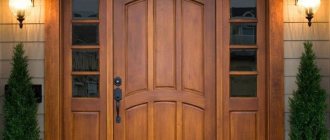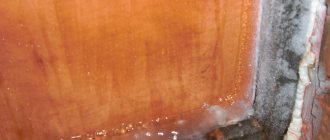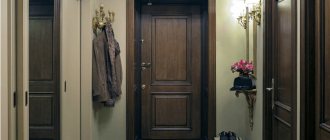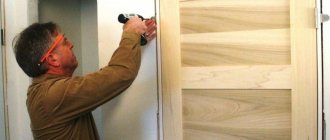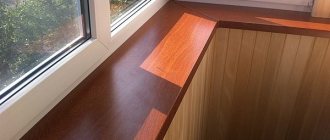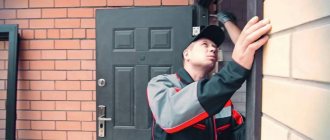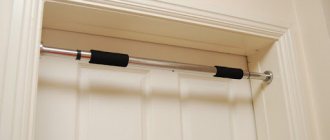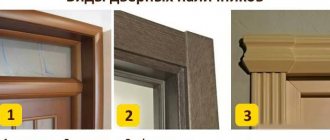What kind of noise, what kind of din: how to isolate yourself from extraneous sounds with your own hands?
Sound insulation is the very advantage for which metal doors are so valued. Thanks to the massive structure at the entrance, we don’t hear neighbors smoking on the stairs, the slamming entrance door, or the rising elevator. But not every manufacturer is responsible for installing sound insulation on doors. Inexpensive models may even be supplied to the market without special material inside that blocks noise. In this case, you can buy a more expensive model, or you can improve the door yourself. Read how to soundproof a metal entrance door in an apartment.
What affects the level of sound insulation of a door
Let us immediately note that many consumers, installing expensive doors from well-known manufacturers (Russian, Belarusian and Polish companies), mistakenly believe that the noise problem is solved automatically.
In practice, you can even hear footsteps on the staircase in the apartment. And it’s not a matter of poor sound insulation of the door - it meets the standards and blocks 30-40 dB of noise. Everything is in the nuances of installation and the condition of the landing:
- during the sealing of the technological gap between the frame and the wall with mounting foam (cement mortar), sound bridges were left: the wedges (linings) were not removed or the sealing seam was allowed to rupture in the area of the mounting reinforcement;
- when installing the door block, iron rods were used as linings under the frame, which were subsequently simply cut with a grinder;
- when sealing the slopes, they did not place mineral wool between the wall and the extension - they left an air space;
- mistakes were made during installation of the seal: different tension of the elastic around the perimeter of the door leads to different pressing forces of the door leaf to the frame in different places;
- there were hidden wall cracks in the area of the doorway;
- the eccentric responsible for the clamping force is not adjusted - the seal practically does not compress;
- the seal is damaged;
- the entrance is echoey, there are no materials that absorb sounds - leather or leatherette door trim or wood lining.
For economy class doors, the quality of sound insulation is additionally affected by:
- thickness of the metal sheet on the door leaf;
- thickness of the door block in general and the leaf in particular;
- type and thickness of the filler between the sheets of door leaf;
- the presence of a thermal break (in simple words: whether or not the insulation was installed inside the door frame - not to be confused with the canvas).
Attention: experience shows that doors of expensive segments (Premium, Elite, VIP class, such as Torex) have a problem with good sound conductivity, usually in the sealing rubber.
Therefore, before starting large-scale work on soundproofing the door, you should check the operation of this element of the door structure. You can use two methods:
- apply chalk to the seal and open and close the door several times - uneven chalk residues on the surface indicate poor sound insulation in the area where the door panel adheres to the frame;
- insert a sheet of paper alternately into the door slot on each side of the leaf and move it in different directions. If different forces are required to manipulate the paper, the problem is in the compactor.
Why so loud?
There are many reasons for poor sound insulation, sometimes they form a powerful tandem, which makes the situation even worse:
- door design - if during production the door is based on a single-circuit design, you can’t expect silence. Double-circuit profiles are more effective in this sense,
- steel thickness - the thicker the steel sheet, the better it blocks sounds. Doors with a sheet thickness of 5mm are suitable,
- finishing materials - if the door is covered with leather, lining or MDF, sound vibrations are better damped,
- internal material - a material is laid between the steel sheets, which is responsible for the function of blocking noise. Cheap and beloved polystyrene foam and corrugated cardboard cannot cope with such a mission, but mineral wool will definitely create silence in the hallway,
- the quality of the gasket is true, and there are nuances here - if the material does not lie tightly, then sound enters the apartment through the gaps,
- installation errors - one poorly sealed slope is enough for the elevator to be heard as if it were in your hallway.
Ways to improve the sound insulation of your front door
Treatment of the disease is impossible without a diagnosis. So in our case, improving the sound insulation of the front door without knowing the reasons is expensive and labor-intensive. Therefore, we will indicate ways to improve the level of noise insulation by block:
1. Door frame. Here are several places where you can improve protection against various noises and, therefore, several ways to do this:
- replace the seal;
- install rubber seals along two contours - metal doors allow this;
- install threshold slats with nylon brushes;
- insulate the slope, which allows you to dampen sound waves penetrating into the apartment through wedges, microcracks in the wall or breaks in the seam made of polyurethane foam when sealing the technological gap;
- insulate the frame from the inside of the door: stick on decorative overlays made of MDF, wood, plastic, etc.
2. Door leaf. It is not advisable to carry out any work to improve the sound insulation of the door leaf at the doors of the expensive segment. With significant financial costs, this indicator can be improved by only 5-10%. Another thing is inexpensive doors, where the level of sound wave attenuation can be increased to 70%. Here you can do the soundproofing of a metal entrance door with your own hands by:
- laying soundproofing filler inside the door leaf - if the inner sheet of the leaf is removable;
- replacing the metal sheet of the door leaf on the apartment side with a sheet of MDF, PVC, wood, etc. — the resonance effect disappears;
- upholstery of the outer side of the door with leatherette, leatherette or natural leather, under which a soundproofing substrate made of one type of material or a combination of several is placed;
- performing similar work inside the apartment;
- installation of second doors;
- vestibule extensions.
The seal is our everything
If the material in the door is not many years old, but you clearly feel street noise and draft coming from the iron door, you should try replacing the door seal with a more advanced one. A material made of synthetic rubber will improve sound insulation, but silicone also copes well with its role. There are products on self-adhesive film, which you just need to separate from the film, apply to the door and iron it with force.
You need to buy a rubber seal with a reserve; its length should be at least 30 cm longer than the perimeter of the door. Measure the door around the perimeter, multiply the figure by the number of layers (the minimum should be 2, and preferably 3) and go shopping. The sealing rubber is sold in rolls of 6 meters, which is enough for a standard door. Read more about this in our article.
Types of soundproofing materials for entrance doors
Knowing the reasons why noise enters an apartment, as well as methods to combat it, there is little left to do: find out how to soundproof the front door in an apartment with your own hands. First you need to purchase materials.
When replacing the seal or pasting it on the second contour of the door frame, it is necessary to purchase a sealing rubber band with a length exceeding the perimeter to be pasted by at least 20 cm. In one piece. The material may be different:
- rubber;
- plastopolymers (TPE);
- artificial rubber;
- silicone;
- foam rubber
Each material has its own strengths and weaknesses. You can learn more about them in the work: “How to replace the rubber seal on plastic windows?”, subsection 4.2.
For doors, experts recommend using rubber or artificial rubber seals. Silicone is much more expensive, but in terms of consumer properties and service life it is almost the same as the materials noted above. Foam rubber quite quickly loses its shape (deforms) in places of increased compression.
Foam rubber.
Various materials can be used as filler. When making a choice, you need to consider the following points:
- the material must be environmentally friendly;
- have high levels of heat and sound protection;
- do not absorb moisture;
- have a service life commensurate with the service life of the doors;
- to be in the middle price sector - to be affordable to the mass consumer.
To the greatest extent, the above requirements are met by mineral wool from rocks (basalt wool), polystyrene foam, penoplex, polyurethane foam, foam propylene and corrugated cardboard for the budget version of doors.
Mineral wool.
Mineral wool from rocks. This is one of the rare building materials that has practically no drawbacks, except for one thing - when wet by 2%, thermal conductivity increases by 10%, which is not a problem for metal entrance doors in apartments and houses. Among the advantages it should be noted:
- affordable price;
- environmental friendliness;
- high levels of noise and heat protection;
- resistance to high temperatures and open fire;
- resistance to aggressive chemicals;
- long service life.
Attention: it is advisable not to use other types of mineral wool: slag wool and glass wool due to a large number of disadvantages: they absorb water, have low sound absorption and high thermal conductivity, and settle over time, forming voids. In addition, slag wool, when in contact with water, releases acids that corrode the metal.
Styrofoam. The filler has:
- low thermal conductivity with high absorption of sound waves;
- long service life without loss of consumer properties;
- affordable price.
In addition, it is frost-resistant and non-hygroscopic. Safe for people - does not emit harmful substances.
Among the disadvantages:
- instant flammability upon contact with fire;
- release of toxic substances into space during combustion.
Foamed polyurethane. The industry produces two types of insulation from this material: elastic and rigid. To fill the doors, you need to purchase a hard version. He:
- lightweight and durable;
- not afraid of water;
- durable;
- good insulation;
- effectively absorbs noise;
- environmentally friendly
Among the disadvantages, it is necessary to note the higher price compared to basalt wool and polystyrene foam and good flammability with the release of toxic combustion products.
Penoplex. The material has:
- low thermal conductivity - about 0.030 W/m;
- high level of noise absorption - 45%;
- resistance to moisture - in 28 days it gets wet by only 0.5%;
- long service life - 50 years.
It can be used in a wide temperature range from –50oC to +75oC.
The negative aspects of the material include:
- quite high price;
- ability to quickly ignite;
- susceptible to attacks by mice and rats - they eat with pleasure.
Foampropylene. One of the best synthetic fillers, which has:
- light weight;
- high technology;
- resistance to chemical reagents;
- excellent hydro, heat and sound insulation properties;
- service life is about 70 years;
- no shrinkage.
The disadvantages include the same flammability, but it ignites only at +120oC.
Corrugated cardboard. The cheapest filler with average sound insulation and low weight. Another advantage is the low price. Among the disadvantages is destruction under the influence of moisture.
The door filler is made of corrugated cardboard.
Now let's look at how to improve the sound insulation of the front door when upholstering it. In this case, you can use mineral wool, isolon, synthetic winterizer, vibroplast, Splen, Bimast.
Izolon. A modern material obtained by foaming polyethylene with propane. Possesses:
- excellent heat and sound protection characteristics;
- low water absorption - less than 1%;
- high manufacturability - easy to cut and simple to install;
- increased elasticity and flexibility;
- environmentally friendly - does not emit toxic substances and does not cause allergic reactions;
- light weight;
- long service life - about 100 years.
Among the disadvantages, we note only the high cost.
Izolon.
Sintepon. In terms of price/quality ratio, this is the best acoustic material of all those offered on the building materials market. In addition, it does not support open combustion.
Vibroplast. The material came to the construction industry from the automotive industry, where it has been used for a long time. It is a self-adhesive composite of aluminum foil and polymers. Easily laid on complex terrain without heating.
The advantages include moisture resistance, flexibility, elasticity and the ability to dampen vibration noise. The only disadvantage is the high price.
Splen. Another material that came into construction from the world of motors. It has excellent sound-absorbing characteristics with average thermal conductivity. Due to the small thickness (4 mm), when upholstering doors, you can create a sandwich of several materials.
This approach increases heat and noise protection (recently the combination of splen + synthetic winterizer, in which sound absorption reaches 50-60 dB, has been very popular).
Bimast. Modern vibration-absorbing material based on bitumen. It is used only in the form of a sandwich, where it acts as a gasket between the metal sheet of the door leaf and the soundproofing material. Like Spleen, it is increasingly used for soundproofing metal doors.
Bitumen vibration dampers.
The material has several serious disadvantages:
- begins to melt and flow down at temperatures above 30oC;
- Applicable only to metal surfaces;
- complex application technology;
- the metal surface must be perfectly cleaned of grease;
- attached while hot - you need a hair dryer.
A party at the neighbors or a raging hammer drill
It turns out that the sounds are different. They can be equally unpleasant, but their nature from a physical point of view is different.
- Drums. The patter of feet on the landing, the sounds of construction tools. It seems that even the walls vibrate when they sound. Such acoustics cannot be completely drowned out, but a good door will help reduce the volume.
- Airborne. Music, loud conversation, barking dog, children's games. These sounds travel only through the air. Doors are able to completely absorb them.
Instructions for soundproofing a door yourself
Each technological process in construction has its own order of work. And it always starts with materials and tools.
Materials and tools
Before soundproofing the front door, you need to buy materials and collect the necessary tools. Materials you will need:
- filler;
- soundproofing substrate;
- upholstery;
- decorative nails;
- seal;
- self-tapping screws;
- glue;
- polyurethane foam.
The toolkit should include:
- hammer;
- electric drill with a set of drills;
- stapler;
- a screwdriver or several Phillips and slotted screwdrivers;
- scissors;
- hair dryer for construction work;
- knife with removable blades.
The given list of tools and materials is always detailed for a specific method of sound insulation.
Seal installation
In most cases, replacing the seal solves the problem of a noisy apartment. The step-by-step work algorithm is as follows:
- a sealant is purchased. It should be slightly longer than the perimeter of the doors, the width should not extend beyond the rebate of the door frame, and the thickness should be 2-3 mm greater than the gap between the door leaf and the frame.
This indicator is the most important - it determines the protection of the apartment from the penetration of noise and cold, as well as the easy closing of doors. The material will be thinner - the room will be noisy, thicker - the door will be difficult to close. In order not to guess, but to immediately buy the necessary seal, you need to do a little trick: plasticine wrapped in plastic film is pressed into the fold of the door. Add 3 mm to the resulting thickness of compressed plasticine - the dimensions of the sealing gum are obtained.
- the entire perimeter is degreased with alcohol, white spirit, acetone or special solutions;
- the corner from which work will begin is coated with universal glue;
- the tip of the seal is cut at an angle of 45o, the protective film is removed from it by about 40-50 cm, after which the elastic is glued to the corner;
- Gradually removing the protective film, glue the elastic around the perimeter of the box, laying it quietly, without pulling;
- the end of the seal is also cut at an angle of 45o and glued to the beginning of the elastic band;
- Using your hands or a special roller, the seal is rolled along the entire length to the box material.
Door seal.
Replacing the filler
You can increase the sound insulation of your front door by replacing the filler with a more efficient material (this method is only possible for collapsible doors). For this:
- the door leaf is removed from the hinges and laid with the inside facing up;
- the handle and lock linings are removed;
- the inner sheet of the canvas is dismantled;
- the existing filler is removed;
- new filler is installed. If it is self-adhesive (isolon, polyethylene foam), there is no need to carry out additional operations. If there is no glue on the material, then the outer sheet is degreased and then lubricated with special glue (“Moment”, “Superglue”, etc.);
Attention: the glue is applied in small strips. For mineral wool such an operation is not provided.
- filler joints are foamed with mounting foam or clogged with mineral wool;
- the edges of the removed panel along the entire contour are lubricated with any type of sealant;
- the door leaf is returned to its place;
- the removed fittings are installed;
- the door is hung on hinges.
Mineral wool filler.
Door trim
The most effective option for soundproofing doors is their upholstery, regardless of whether it is made inside or outside the apartment. Several problems are solved here:
- the apartment is protected from noise on the landing;
- the doorway is insulated;
- the appearance of the door leaf improves.
Many owners call specialists to carry out upholstery work. But even beginners can do such work on their own. Enough desire and patience. Here are instructions for door trim.
- Remove the decorative nails that secured the old trim to the door leaf. Remove the fittings.
- Remove the upholstery.
- Remove old insulation, as well as hardboard or fiberboard if they are under the upholstery.
- Wipe the surface of the door leaf with acetone or alcohol - degrease.
- Glue vibration-proof material (which material to choose, see above).
- Using adhesive-sealant, stick foam rubber, padding polyester or other lightweight sound insulator onto the bitumen material.
- Trim off excess material.
Attention: mineral wool is attached with a fishing net to a door laid horizontally.
- Upholstery is being carried out.
In the minds of the average person, upholstery is associated with leatherette, artificial or natural leather. In fact, upholstery can also be done with various panels.
Leather door upholstery.
To install the panels you need:
- install the sheathing along the edge of the door leaf using self-tapping screws (you must drill a hole in the slats for them in advance);
- cut holes in the panel for peepholes, locks and handles;
- attach the panel to the sheathing with liquid nails;
- treat the joints of the plank and panel with silicone sealant;
- decorate the sheathing at the end of the doors with special strips;
- install fittings.
Door leaf and its filling for reliable sound insulation
The moving part of the door is the very door leaf. This, in fact, is what we used to call a door.
Doors with frame structure and sound insulation system
In our case, the door leaf has a frame structure. This design option will allow, firstly, to lighten the weight of the structure, and secondly, it ensures the presence of an internal cavity that can be filled with sound-absorbing material.
Soundproofing a wooden entrance door
There are two ways to protect yourself from various types of noise when using wooden entrance doors:
- stick the seal on the door frame;
- upholster the door with leatherette (genuine leather) or leatherette.
The technology for gluing the sealing gum is discussed above. We will consider leatherette (leather) upholstery below.
- The door is removed from its hinges and placed on the floor or table.
- The handles, peephole and lock linings are removed.
- Along the entire perimeter of the door, strips of leatherette (leather) 15 cm wide, wrong side up, are nailed in 10 cm increments.
- Leatherette is cut with an overlap of 5 cm around the entire perimeter.
- Foam rubber or padding polyester is attached to the door with a stapler. Holes are cut in the material at the locations of the eye, handles and lock.
- Batting is attached on top of the foam rubber - it extends the service life of the insulator.
- At the top of the door, in the middle, leatherette (leatherette) is attached with a nail. The same operation is performed from below.
- In increments of 10 cm, the decorative canvas is nailed to the door along the entire perimeter.
- The batting is cut into strips, rolled into rolls, after which the previously nailed strips are attached to the door with decorative nails.
- The peephole, lock linings and handle are returned to their place.
- If desired, you can nail a decorative cord in the form of a beautiful pattern.
With a mustache ourselves: getting rid of noise yourself
You can invite a professional craftsman to install new soundproofing material, seal slopes and thresholds. Or you can use our lifehacks and try to “turn off the sound” yourself. The procedure may vary depending on the design of the door, so carefully study the procedure so that you do not have to redo the work again.
We create silence with our own hands:
- dismantle the accessories: chain, lock, peephole, handle,
- take the door out of the frame and place it on the floor - this will make it easier to work with,
- if the front door can be disassembled for sound insulation, remove everything that can be dismantled - decor, fittings, then open the door, removing the back sheet of steel, then the insides of the door between the two sheets of steel are filled with new material and closed again with a steel sheet,
- In order to effectively make noise from a non-removable door, you will first have to make a frame, and then fill it with insulation with sound-proofing properties, and then cover it with finishing materials: clapboard, MDF, eco-leather.
Are there any alternative options
An alternative option would be to install a vestibule with an additional wooden door, which is mounted according to the principle of an interior door. This is suitable for private houses, cottages and apartments, in which the hallway area allows you to occupy part of the space without limiting the functionality of the room.
Double block doors always open in different directions, this is due to the peculiarity of this design. Therefore, using this method of sound insulation is problematic in small corridors of typical apartments. In other cases, installing a vestibule with an additional entrance door will solve not only the problem of sound insulation, but will also help retain heat, eliminate extraneous odors from the street and increase protection against uninvited guests entering the house.
